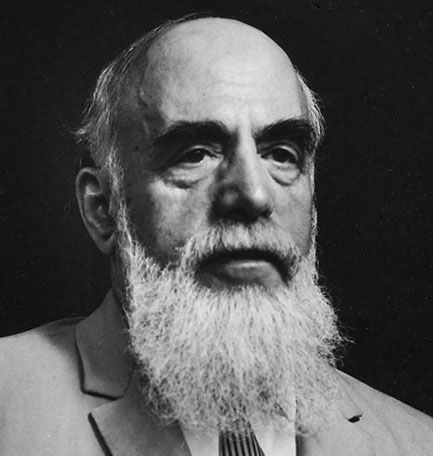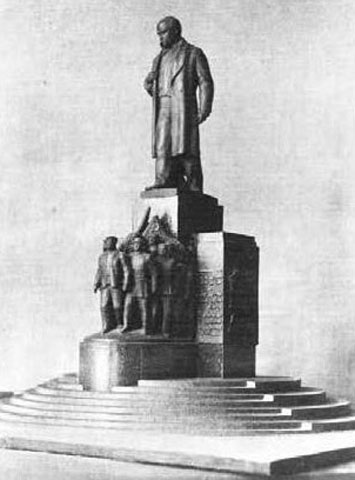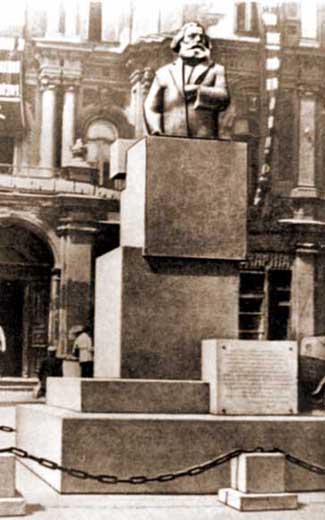Chaikov, Joseph
Chaikov, Joseph or Tchaikov, Iosif [Чайков, Йосиф], b 1 December 1888 in Kyiv, d 4 March 1979 in Moscow. Sculptor and graphic artist. In 1908 Chaikov joined an engraving workshop in Kyiv, first as an apprentice and later as a journeyman. In 1910, with the support from sculptor Naoum Aronson, he was awarded a scholarship to study in Paris. There he studied in Aronson’s studio, attended the High School of Decorative Arts (1910–12), and then continued his studies at the High School of Fine Arts (1912–13). In 1912, together with other young Jewish artists in Paris, Chaikov co-founded the Mahmadim group that aimed to develop a distinct Jewish national style in art.
He returned to Kyiv in 1914. In 1918, together with Issachar Ber Ryback, El Lissitzky, Mark Epstein, and others, he established the Kultur Lige’s art section and taught sculpture there. He also illustrated Yiddish books and became the head of the Lige’s children’s art studio. In February 1919 his plaster bust of Karl Marx, set on a wooden pedestal, was unveiled in Kyiv shortly after the city was captured by the Red Army, but the monumnt was destroyed in August of that year after Kyiv was occupied by Gen Anton Denikin’s Volunteer Army. Later, plans to restore this bust emerged in 1921 and, in 1922, Chaikov oversaw the design and casting of its new version, made of plaster coated with bronze patina. That plaster sculpture was unveiled on 1 May 1922 during a grand public ceremony attended by 10,000 spectators and remained in its place until it was surreptitiously destroyed in 1933.
In the early 1920s Chaikov’s artistic approach shifted toward cubism. In 1920 he co-organized the Kultur Lige’s First Jewish Art Exhibition in Kyiv and became known as an ideologist of new Jewish art that built on the influences of Old Orient sculpture, early 20th-century Orientalism, and Art Nouveau. In 1921 he published a Yiddish-language brochure outlining his artistic vision, in which he rejected ethnographic and folkloric influences in favor of modernist aesthetics. His work was featured alongside Marc Chagall, Natan Altman, and El Lissitzky in Boris Aronson’s book on modern Jewish graphic art. From 1922 to 1923 Chaikov worked in Berlin, participating in the exhibition of Soviet art, the November Group exhibition, and the Berlin International Exhibition in 1923.
After relocating to Moscow in 1924, Chaikov taught there at the Higher Institute of Art and Technology (1924–34). In 1925 he joined the Society of Russian Sculptors and was elected its chairman in 1929. Adopting the principles of socialist realism, he played an active role in implementing Vladimir Lenin’s ‘Plan of Monumental Propaganda.’ Throughout his career Chaikov created numerous monuments, busts, individual sculpted portraits, and decorative sculptures. His more notable works include Football Players (plaster, 1928; bronze, 1939), Gymnast (copper, 1957), Diving (porcelain, 1959; tinted plaster, 1960), and Scuba Divers (aluminum, glass, marble, 1961).
From 1928 to 1933 Chaikov worked on a project of a multi-figure monument dedicated to Taras Shevchenko for the city of Kharkiv, which depicted Shevchenko standing on a pedestal above a group of workers holding a flag. In 1933 he created a design for another Shevchenko monument for the poet’s grave in Kaniv, in which he portrayed Shevchenko surrounded by protagonists of is poetic works. These monuments were never completed, but the photographs of these projects are preserved at the Taras Shevchenko National Museum. Chaikov also created a plaster sculptural portrait of Shevchenko in 1930.
BIBLIOGRAPHY
Chlenov, A. Iosif Moiseevich Chaikov (Moscow 1952)
Kampf A. ‘In Quest of the Jewish Style in the Era of the Russian Revolution,’ Journal of Jewish Art 5 (1978)
Apter-Gabriel, Ruth, ed. Tradition and Revolution: The Jewish Renaissance in Russian Avant-Garde Art, 1912–1928 (Jerusalem 1987)
Larysa Bilous
[This article was written in 2022.]


.jpg)

.jpg)